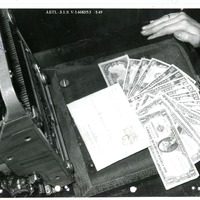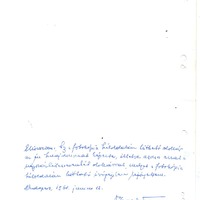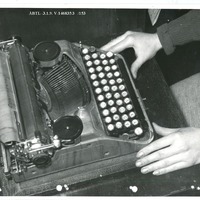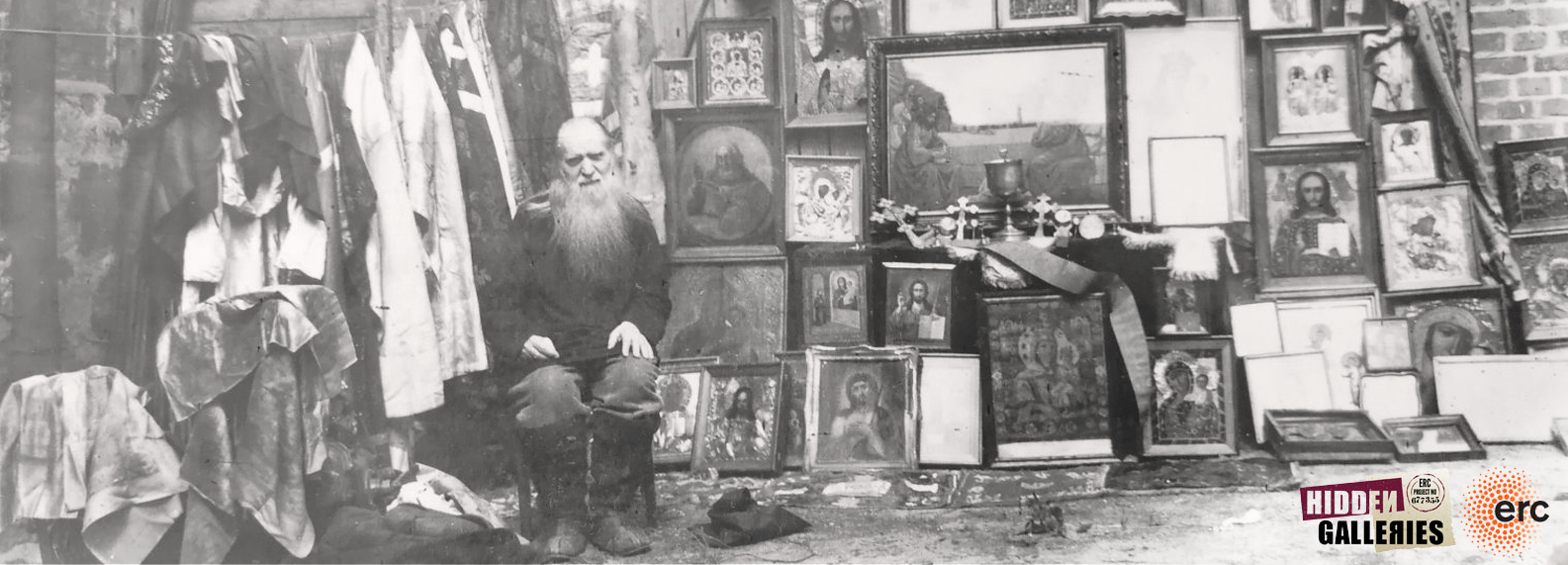Evidence of illegal activity of underground Catholic religious order Hungary
Item
Title
Evidence of illegal activity of underground Catholic religious order Hungary
Bizonyíték egy illegálisan működő katolikus szerzetesrend vallási tevékenységére vonatkozóan
Description
This picture depicts a Continental typewriter confiscated during a house search of a Hungarian Cistercian monk, Dr. Ferenc Piusz Halász (1909-1994) in 1961. The typewriter was photographed along with illegally held US dollars. Three photo images were taken by the secret agents in order to show how the US dollars were hidden in an envelope inside the typewriter. On the reverse of the photograph we find the following text:
"Elismerem, hogy a fotokópia hátoldalán látható dollár az én tulajdonomat képezte, illetve azonos azzal a négyszázkilencvenhét dollárral, melyet a fotokópia hátoldalán látható írógépben rejtegettem. Budapest, 1961. június 12., Dr. Halász Ferenc"
"I acknowledge that the dollars on the other side of this photographic image are my property and are identical with the 497 dollars that I hid in my typewriter which is found on the photo as well. Budapest, 12th June, 1961. Dr. Ferenc Halász."
These pictures served as one of the main pieces of evidence against Dr. Ferenc Piusz Halász when he was given a 6 year prison sentence in 1961. This constituted the main evidence against Dr. Ferenc Piusz Halász, one of the main defendants of a show trial against the underground Cistercians. The images here follow the classic model how evidence was found. The sequence of shots demonstrate a classic photographic methodology of how secret police produced incriminating evidence. In this case we can assume that the dollars were planted by the secret police agents. Similar to show trials - where the authorities have already determined the guilt of the defendant(s) –house search scenario was usually constructed in a way that the forbidden western foreign money – in this case US dollars – was hidden and then found by the officers on the spot. The possession of foreign currency was considered a criminal offence according to the state and served as unambiguous evidence against the incriminated person.
Typewriters of persons under surveillance or persecution had a significant role in the eye of the secret police as the uncontrolled typewriters provided means for the production and circulation of uncensored documents, messages or spiritual writings. For this reason, typewriter can also been seen as the symbol of free speech. By producing a sample from the typewriter, it is possible to identify the typewriter later and get an insight into the distribution network of religious samizdat and the volume of produced materials.
Dr. Ferenc Piusz Halász was a member of the Cistercian order dissolved in 1950. He was one of the main defendant of the show trial against the underground Cistercian order after the dissolution of most Catholic religious orders in 1950. From 1946 he was the Prior of the austere, ascetic Borsodpuszta Cistercian community. He was active in producing religious writings. After the dissolution of the order, Dr. Ferenc Piusz Halász was a parish priest in Csatka from 1951-1961. The persecution against him began in 1961. According to the charges of the show trial he was one of the ideological leaders of priests and monks organizing the overthrow of the political system. During his allegedly subversive, anti-state efforts he copied and re-produced the sermon-collection “Preach the Gospel!” which served as an evidence for the trial. Dr. Ferenc Piusz Halász was convicted for 6 years of prison but was freed in 1963 as part of the collective political amnesty but convicted again in 1965 with a similar sentence.
The photo image is found in ÁBTL 3.1.9. V-146835/3
For related entries see:
"Elismerem, hogy a fotokópia hátoldalán látható dollár az én tulajdonomat képezte, illetve azonos azzal a négyszázkilencvenhét dollárral, melyet a fotokópia hátoldalán látható írógépben rejtegettem. Budapest, 1961. június 12., Dr. Halász Ferenc"
"I acknowledge that the dollars on the other side of this photographic image are my property and are identical with the 497 dollars that I hid in my typewriter which is found on the photo as well. Budapest, 12th June, 1961. Dr. Ferenc Halász."
These pictures served as one of the main pieces of evidence against Dr. Ferenc Piusz Halász when he was given a 6 year prison sentence in 1961. This constituted the main evidence against Dr. Ferenc Piusz Halász, one of the main defendants of a show trial against the underground Cistercians. The images here follow the classic model how evidence was found. The sequence of shots demonstrate a classic photographic methodology of how secret police produced incriminating evidence. In this case we can assume that the dollars were planted by the secret police agents. Similar to show trials - where the authorities have already determined the guilt of the defendant(s) –house search scenario was usually constructed in a way that the forbidden western foreign money – in this case US dollars – was hidden and then found by the officers on the spot. The possession of foreign currency was considered a criminal offence according to the state and served as unambiguous evidence against the incriminated person.
Typewriters of persons under surveillance or persecution had a significant role in the eye of the secret police as the uncontrolled typewriters provided means for the production and circulation of uncensored documents, messages or spiritual writings. For this reason, typewriter can also been seen as the symbol of free speech. By producing a sample from the typewriter, it is possible to identify the typewriter later and get an insight into the distribution network of religious samizdat and the volume of produced materials.
Dr. Ferenc Piusz Halász was a member of the Cistercian order dissolved in 1950. He was one of the main defendant of the show trial against the underground Cistercian order after the dissolution of most Catholic religious orders in 1950. From 1946 he was the Prior of the austere, ascetic Borsodpuszta Cistercian community. He was active in producing religious writings. After the dissolution of the order, Dr. Ferenc Piusz Halász was a parish priest in Csatka from 1951-1961. The persecution against him began in 1961. According to the charges of the show trial he was one of the ideological leaders of priests and monks organizing the overthrow of the political system. During his allegedly subversive, anti-state efforts he copied and re-produced the sermon-collection “Preach the Gospel!” which served as an evidence for the trial. Dr. Ferenc Piusz Halász was convicted for 6 years of prison but was freed in 1963 as part of the collective political amnesty but convicted again in 1965 with a similar sentence.
The photo image is found in ÁBTL 3.1.9. V-146835/3
For related entries see:
A fényképen egy Continental táskaírógépet láthatunk, amely Halász Piusz (1909-1994) ciszterci perjelnél folytatott házkutatás során került lefoglalásra 1961-ben. A táskaírógépet a benne elrejtett, illegálisan birtokolt valutával együtt fotózták le. Az ügynökök három képpel illusztrálják, hogy az amerikai dollárt hogyan rejtették el egy borítékban az írógép belsejében. A fénykép hátoldalán a következő szöveget találjuk: „Elismerem, hogy a fotokópia hátoldalán látható dollár az én tulajdonomat képezte, illetve azonos azzal a négyszázkilencvenhét dollárral, melyet a fotokópia hátoldalán látható írógépben rejtegettem. Budapest, 1961. június 12., Dr. Halász Ferenc”
Ez a képsorozat szolgáltatta az 1950-ben betiltott ciszterci rend földalatti papjai ellen irányuló koncepciós per egyik fő bizonyítékát. Halász Piuszt, a per egyik fő vádlottját, 1961-ben hat év börtönbüntetésre ítélték.
A képek bemutatják a bizonyítékok feltárásának bevett titkosszolgálati módszerét. A felvételsorozat jól szemlélteti azt a klasszikus fényképezési módszert, amellyel a titkosrendőrség terhelő bizonyítékokat állított elő. Ebben az esetben feltételezhetjük, hogy a dollárokat a titkosrendőrök helyezték el az írógépben. Az ilyen jellegű házkutatások – hasonlóképpen a koncepciós perekhez – már előre megkonstruáltak voltak, az ügynökök által előzetesen elrejtett, majd a helyszínen meglelt bizonyítékokkal. Ez a bizonyíték gyakran a tiltott nyugati valuta volt – jelen esetben amerikai dollár – amelynek engedély nélküli birtoklása bűntettnek minősült és egyértelmű terhelő bizonyítéknak számított.
A titkosrendőrség számára a megfigyelt és bűnvádi eljárás alá helyezett személyek írógépei különös jelentőséggel bírtak, mivel az ellenőrizetlenül birtokolt készülékekkel cenzúrázatlan írásokat, üzeneteket, vagy lelkiségi iratokat lehetett sokszorosítani és terjeszteni. Emiatt az írógép a szólásszabadság szimbólumává vált. Az írógépen előállított minta segítségével képesek voltak beazonosítani a későbbiekben megjelenő szamizdat anyagok alkotóit, valamint ráláttak a vallási szamizdat terjesztési hálózatára és az általuk előállított anyagok mennyiségére.
Dr. Halász Ferenc Piusz szerzetespap volt az 1950-ben betiltott ciszterci rend földalatti papjai elleni koncepciós perek egyik fő vádlottja. Halász 1946-tól Borsodpusztán a szigorú regulájú ciszter szerzetesi közösség vezetője volt. Élénk publicisztikai tevékenységet fejtett ki. A rend feloszlatása után, 1951-1961 között, Csatkán szolgált plébánosként. 1961-ben indult ellene eljárás. A koncepciós kirakatper vádpontjai szerint ő volt az ideológiai vezetője annak a papokból és szerzetesekből álló társaságnak, amely a politikai rendszer megdöntésére készült. Az államellenes szervezkedés vádja során Halász Piusz írógéppel sokszorosított, illegálisan terjesztett ’Hirdessétek az Evangéliumot!’ című prédikáció-gyűjteménye volt az egyik bizonyíték. A valutaüzérkedés a vádlott feltételezett alvilági kapcsolatait igazolta volna az eljárás során. Halászt hat év börtönre ítélték. 1963-ban szabadult amnesztiával, amikor az 1956-os forradalom után hatalomra került Kádár-rendszer (1956-1989) amnesztiát hirdetett a politikai okokból bebörtönzöttek számára. 1965-ben ugyanezen vád alapján újból börtönbe került.
A fotók az ÁBTL 3.1.9. V-146835/3 dossziéban találhatók.
Kapcsolódó bejegyzések:
Subject
Hungary--History--20th century
Religion and state--Europe
religion and state
secret police
Religion--History--20th century
Communism and Christianity
Communism--Hungary
Religious groups
ÁVO ; ÁVH ; Államvédelmi Hatóság ; Hungarian Secret Police
evidence fabrication
Cistercian
Religion and state--Europe
religion and state
secret police
Religion--History--20th century
Communism and Christianity
Communism--Hungary
Religious groups
ÁVO ; ÁVH ; Államvédelmi Hatóság ; Hungarian Secret Police
evidence fabrication
Cistercian
Creator
Kinga Povedák
Source
Állambiztonsági Szolgálatok Történeti Levéltára
ÁBTL 3.1.9. V-146835/3
ÁBTL 3.1.9. V-146835/3
Publisher
This project has received funding from the European Research Council (ERC) under the European Union’s Horizon 2020 research and innovation programme No . 677355
Date
1961
Rights
copyright for these images belongs to ÁBTL
Format
image/tif
photo
Language
HUN
Type
image
Identifier
ÁBTL 3.1.9. V-146835/3
Coverage
20th century, Hungary
Date Created
2018
Item sets
 The typewriter and the US dollars photographed as incriminating evidence
The typewriter and the US dollars photographed as incriminating evidence  The reverse of the photograph with a signed statement
The reverse of the photograph with a signed statement  The hidden envelope inside the typewriter
The hidden envelope inside the typewriter  The typewriter photographed as evidence
The typewriter photographed as evidence 